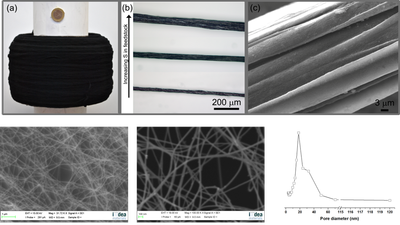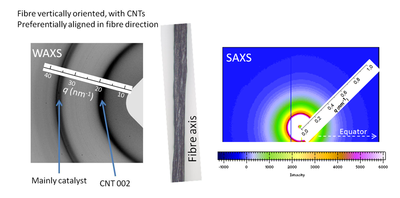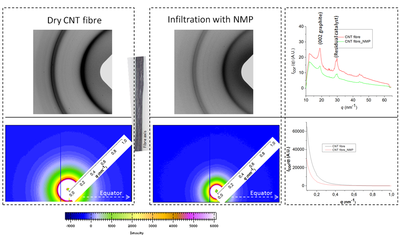At IMDEA Materials Institute, this assembly is carried out by directly spinning continuous macroscopic fibers made up of carbon nanotubes (CNT) of controlled number of layers, ranging from singlewalled to multiwalled [1]. For a video of the spinning process visit our website.
CNT fibres at different length scales have a unique porous yarn-like (hierarchical) structure, with the subfilaments being the nanotube bundles (Figure 1). The high internal surface area (270 m2/g) of this comparatively open structure is readily accessible to liquid/polymer molecules; liquid/polymer infiltration occurs without applying pressure and is simply driven by capillary forces, thanks to its yarn-like structure [2].
Composite properties of interest (such as load transfer) are clearly expected to be influenced by the degree of infiltration of molecues into these fibre yarns across different length-scales. Synchrotron X-ray diffraction recording simultaneously SAXS and WAXS patterns in NCD beamline, as shown in Figure 2, is essentially providing us with multi scale structural information about the CNT fibres, ranging from a few microns to a few angstroms.
By monitoring the structural changes during the ingress of liquid into dry CNT fibre, it is expected to better understand some of the key issues when the yarn-like fibre contacts with polar liquid. A case study of N-Methyl-2-pyrrolidone (NMP) infiltration into the CNT fibres as an example is illustrated in Figure 3. Interestingly, there is no evidence that the scattering peak from 002 CNT plane of inter-graphene layers is affected in scattering vector q value upon NMP infiltration, indicating that neither intercalation nor debundling of CNTs from bundles taking place upon interaction with liquids. From a larger scale point of view, a decreased value of invariant is found in the NMP infiltrated fibre, compared with dry CNT fibre, which suggests that NMP molecues are able to penetrate into the voids of the CNT fibre as they have a higher electron density than air. The infiltration of liquid molecules into the fibre changes its bulk electrical conductivity due to the interplay between a higher electron tunneling probability and a slight fibre swelling (3), overall making an interesting sensor of liquids and polymers (4).
This research based on WAXS and SAXS analysis forms integral part of various scientific and industrial projects of the research group, as well as four PhD dissertations currently being carried at IMDEA Materials. It is expected that the results of this work will also contribute to the understanding of composites with graphene and other nano-scale reinforcements, which are also characterized by imperfect packing and therefore substantial porosity.

Figure 1. Images of macroscopic fibres of at different length scales. The porosity of the fibre is demonstrated by high resolution micrographs and BJH desorption measurement.
Figure 2. 2D WAXS&SAXS patterns of CNT fibres as-made showing multi scale structural information.
Figure 3. 2D WAXS patterns (a) of CNT fibres and that infiltrated with liquid N-Methyl-2-pyrrolidone (NMP), together with integrated scattering patterns (b) after azimuthal integration.
References
- Reguero, V.; Alemán, B.; Mas, B.; Vilatela, J. J., Controlling Carbon Nanotube Type in Macroscopic Fibers Synthesized by the Direct Spinning Process. Chemistry of Materials 2014, 26 (11), 3550-3557.
- (a) Vilatela, J. J.; Deng, L.; Kinloch, I. A.; Young, R. J.; Windle, A. H., Structure of and stress transfer in fibres spun from carbon nanotubes produced by chemical vapour deposition. Carbon 2011, 49 (13), 4149-4158; (b) Vilatela, J. J.; Windle, A. H., Yarn-Like Carbon Nanotube Fibers. Advanced Materials 2010, 22 (44), 4959-4963.
- J. Qiu, J. Terrones, J. J. Vilatela, M. E. Vickers, J. A. Elliott, A.H. Windle "Liquid Infiltration into Carbon Nanotube Fibers: Effect on Structure and Electrical Properties". ACS Nano , 2013, 7, 8412-8422.
- J. Terrones, J.A. Elliott, J.J. Vilatela, A.H. Windle "Electric field-modulated non-ohmic behavior of carbon nanotube fibers in poler liquids". ACS Nano, 2014, accepted.






